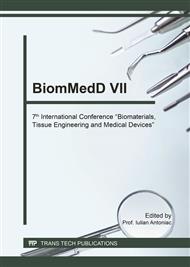[1]
M.L. Quimby, K.W. Vig, R.G. Rashid, A.R. Firestone, The accuracy and reliability of measurements made on computer-based digital models, Angle Orthod. 74 (2004) 298-303.
Google Scholar
[2]
The glossary of prosthodontic terms, J Prosthet Dent. 94 (2005) 10-92.
Google Scholar
[3]
M. Arora, S. Kohli, R. Kalsi, Influence of Custom Trays, Dual-Arch Passive, Flexed Trays and Viscosities of Elastomeric Impression Materials on Working Dies, J Clin Diagn Res. 10 (2016) ZC112-6.
DOI: 10.7860/jcdr/2016/16851.7840
Google Scholar
[4]
T. Balamurugan, P. Manimaran, Evaluation of accuracy of direct transfer snapon impression coping closed tray impression technique and direct transfer open tray impression technique: an in vitro study, J Indian Prosthodont Soc. 13 (2013) 226-32.
DOI: 10.1007/s13191-012-0141-x
Google Scholar
[5]
M.M. Kulkarni, R.U. Thombare, Dimensional Changes of Alginate Dental Impression Materials-An Invitro Study, J Clin Diagn Res. 9 (2015) ZC98-ZC102.
Google Scholar
[6]
M. Vojdani, K. Torabi, E. Ansarifard, Accuracy of different impression materials in parallel and nonparallel implants, Dent Res J (Isfahan). 12 (2015) 315-22.
DOI: 10.4103/1735-3327.161429
Google Scholar
[7]
R. Nagrath, M. Lahori, M. Agrawal, A Comparative Evaluation of Dimensional Accuracy and Surface Detail Reproduction of Four Hydrophilic Vinyl Polysiloxane Impression Materials Tested Under Dry, Moist, and Wet Conditions-An In Vitro Study, J Indian Prosthodont Soc. 14 (2014).
DOI: 10.1007/s13191-014-0365-z
Google Scholar
[8]
A.C. Faria, R.C. Rodrigues, A.P. Macedo, G. Mattos Mda, R.F. Ribeiro, Accuracy of stone casts obtained by different impression materials, Braz Oral Res. 22 (2008) 293-8.
DOI: 10.1590/s1806-83242008000400002
Google Scholar
[9]
N.A. Pande, R.D. Parkhedkar, An evaluation of dimensional accuracy of one-step and two-step impression technique using addition silicone impression material: an in vitro study, J Indian Prosthodont Soc. 13 (2013) 254-9.
DOI: 10.1007/s13191-012-0182-1
Google Scholar
[10]
B.M. Zen, E.F. Soares, M.A. Rodrigues, L.F. Luthi, R.L. Consani, M.F. Mesquita, G.E. Henriques, Comparison of the Accuracy of Different Transfer Impression Techniques for Osseointegrated Implants, J Oral Implantol. 41 (2015) 662-7.
DOI: 10.1563/aaid-joi-d-13-00126
Google Scholar
[11]
N. Kumari, D.B. Nandeeshwar, The dimensional accuracy of polyvinyl siloxane impression materials using two different impression techniques: An in vitro study, J Indian Prosthodont Soc. 15 (2015) 211-7.
DOI: 10.4103/0972-4052.158074
Google Scholar
[12]
H. Siadat, M. Alikhasi, E. Beyabanaki, S. Rahimian, Comparison of different Impression Techniques When Using the All-on-Four Implant Treatment Protocol, Int J Prosthodont. 29 (2016) 265-70.
DOI: 10.11607/ijp.4341
Google Scholar
[13]
S.S. Kamble, R.V. Khandeparker, P. Somasundaram, S. Raghav, R.P. Babaji, T.J. Varghese, Comparative Evaluation of Dimensional Accuracy of Elastomeric Impression Materials when Treated with Autoclave, Microwave, and Chemical Disinfection, J Int Oral Health. 7 (2015).
Google Scholar
[14]
F. Saleh Saber, N. Abolfazli, M. Kohsoltani, The effect of disinfection by spray atomization on dimensional accuracy of condensation silicone impressions, J Dent Res Dent Clin Dent Prospects. 4 (2010) 124-9.
DOI: 10.5897/ajb11.1817
Google Scholar
[15]
T. Hacker, G. Heydecke, D.R. Reissmann, Impact of procedures during prosthodontic treatment on patients' perceived burdens, J Dent. 43 (2015) 51-7.
DOI: 10.1016/j.jdent.2014.10.013
Google Scholar
[16]
P. Padevět, P. Tesárek, T. Plachý, Evolution of mechanical properties of gypsum in time, International Journal of Mechanics. 12 (2011) 124-129.
Google Scholar
[17]
N.J. McGuinness, C.D. Stephens, Storage of orthodontic study models in hospital units in the U. K, Br J Orthod. 19 (1992) 227-232.
Google Scholar
[18]
F. Duret, J.L. Blouin, B. Duret, CAD-CAM in dentistry, J Am Dent Assoc. 117 (1988) 715-20.
DOI: 10.14219/jada.archive.1988.0096
Google Scholar
[19]
M. Mayers, A.R. Firestone, R. Rashid, K.W. Vig, Comparison of peer assessment rating (PAR) index scores of plaster and computer-based digital models, Am J Orthod Dentofacial Orthop. 128 (2005) 431-434.
DOI: 10.1016/j.ajodo.2004.04.035
Google Scholar
[20]
J.F. Güth, C. Keul, M. Stimmelmayr, F. Beuer, D. Edelhoff, Accuracy of digital models obtained by direct and indirect data capturing, Clin Oral Investig. 17 (2013) 1201-8.
DOI: 10.1007/s00784-012-0795-0
Google Scholar
[21]
P. Seelbach, C. Brueckel, B. Wöstmann, Accuracy of digital and conventional impression techniques and workflow, Clin Oral Investig. 17 (2013) 1759-64.
DOI: 10.1007/s00784-012-0864-4
Google Scholar
[22]
M. Rödiger, A. Heinitz, R. Bürgers, S. Rinke, Fitting accuracy of zirconia single crowns produced via digital and conventional impressions-a clinical comparative study, Clin Oral Investig. 2016 Jul 28. DOI: 10. 1007/s00784-016-1924-y.
DOI: 10.1007/s00784-016-1924-y
Google Scholar
[23]
J. Radeke, C. von der Wense, B.G. Lapatki, Comparison of orthodontic measurements on dental plaster casts and 3D scans, J Orofac Orthop. 75 (2014) 264-74.
DOI: 10.1007/s00056-014-0217-9
Google Scholar
[24]
A.P. Keating, J. Knox, R. Bibb, A.I. Zhurov, A comparison of plaster, digital and reconstructed study model accuracy. J Orthod. 35 (2008) 191-201.
DOI: 10.1179/146531207225022626
Google Scholar
[25]
B. Luan, M. Yeung, W. Wells, X. Liu, Chemical surface preparation for metallization of stereolithography polymers, Applied Surface Science. 156 (2000) 26–38.
DOI: 10.1016/s0169-4332(99)00339-6
Google Scholar
[26]
A. Hazeveld, J.J.R. Huddleston Slater, Y. Ren, Accuracy and reproducibility of dental replica models reconstructed by different rapid prototyping techniques, Am J Orthod Dentofac Orthop. 145 (2014) 108–15.
DOI: 10.1016/j.ajodo.2013.05.011
Google Scholar
[27]
K. Murugesan, P.A. Anandapandian, S.K. Sharma, M. Vasantha Kumar, Comparative evaluation of dimension and surface detail accuracy of models produced by three different rapid prototype techniques, J Indian Prosthodont Soc. 12 (2012) 16–20.
DOI: 10.1007/s13191-011-0103-8
Google Scholar
[28]
M. Kasparova, L. Grafova, P. Dvorak, T. Dostalova, A. Prochazka, H. Eliasova, Possibility of reconstruction of dental plaster cast from 3D digital study models, Biomed Eng Online. 12 (2013) 49.
DOI: 10.1186/1475-925x-12-49
Google Scholar
[29]
S.B. Patzelt, S. Bishti, S. Stampf, W. Att, Accuracy of computer-aided design/computer-aided manufacturing-generated dental casts based on intraoralscanner data, J Am Dent Assoc. 145 (2014) 1133-40.
DOI: 10.14219/jada.2014.87
Google Scholar
[30]
W.K. Saleh, E. Ariffin, M. Sherriff, D. Bister, Accuracy and reproducibility of linear measurements of resin, plaster, digital and printed study-models, J Orthod. 42 (2015) 301-6.
DOI: 10.1179/1465313315y.0000000016
Google Scholar
[31]
G.K. Koch, G.O. Gallucci, S.J. Lee, Accuracy in the digital workflow: From data acquisition to the digitally milled cast, J Prosthet Dent. 115 (2016) 749-54.
DOI: 10.1016/j.prosdent.2015.12.004
Google Scholar
[32]
G. Uzun, An Overview of Dental CAD/CAM Systems, Biotechnology & Biotechnological Equipment. 22 (2008) 530-35.
DOI: 10.1080/13102818.2008.10817506
Google Scholar


